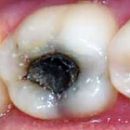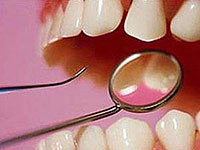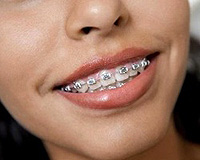The causes of the occurrence of the dental are quite varied. What is the substance of the addecessant tartar? Why is some tissue on the teeth, and others have dark brown, almost black dental stones?
Content
White, yellowish, green, black dental — as soon as these dubious «decorations» on the teeth. In addition to damage to the aesthetics of the dentition, harmless stone deposits play a special role in the development of caries and periodontitis, often lead to the loss of teeth. What are the causes of the appearance of a dental stone? How it is formed? And why in some teeth all their lives remain white, and others look untidy? Let's try to figure it out.
A bit of history
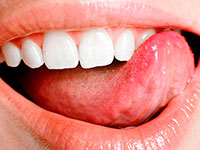 Term «Dental» Appeared in the XVI century, thanks to the famous hencetels of the Swiss-German origin of paracetress, who called all the solid sediments and education in the tissues and human tissues and organs. The reason for the occurrence of the dental stones, Paracels saw in the use of wine, or rather, in contact with a solid sediment, formed on the bottom of the wine bottles during long-term storage. Recommendations for removing dental plates are filled with textbooks for dentists, which have come down from the XIX century. By that time, scientists already considered the presence of a white or black tooth stone harmful to the teeth and tried to get rid of it with various special tools. In Russia, such tools appeared at the beginning of the 20th century. Until 1955, the commercial and fit tooth stone was removed only by mechanical path, now the ultrasound came to shifts, excavators, hooks.
Term «Dental» Appeared in the XVI century, thanks to the famous hencetels of the Swiss-German origin of paracetress, who called all the solid sediments and education in the tissues and human tissues and organs. The reason for the occurrence of the dental stones, Paracels saw in the use of wine, or rather, in contact with a solid sediment, formed on the bottom of the wine bottles during long-term storage. Recommendations for removing dental plates are filled with textbooks for dentists, which have come down from the XIX century. By that time, scientists already considered the presence of a white or black tooth stone harmful to the teeth and tried to get rid of it with various special tools. In Russia, such tools appeared at the beginning of the 20th century. Until 1955, the commercial and fit tooth stone was removed only by mechanical path, now the ultrasound came to shifts, excavators, hooks.
Causes of the appearance of dental stones
Already a few hours after the appearance of a newborn, the newborn cavity is populated by various bacteria, the simplest and even mushrooms, most of which are conditionally pathogenic. They accompany a person throughout life, affect its immunity and under certain conditions cause diseases of the oral cavity.
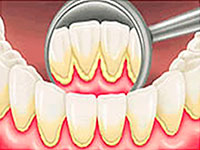 The maximum number of microbes accumulates near the necks of the teeth and in a soft dental. In the dental flask, billions of bacteria are found, which play a special role in the development of caries, gingivitis, periodontitis.
The maximum number of microbes accumulates near the necks of the teeth and in a soft dental. In the dental flask, billions of bacteria are found, which play a special role in the development of caries, gingivitis, periodontitis.
Of the soft dental plates of the surrounding neck of the teeth, gradually impregnizing the salts of calcium and phosphorus, an appropriate tartar is formed. The fit of the raid is formed as a result of the development of gingivitis, accumulation of inflammation products around hidden under the gum of the tooth.
Toothstone is formed if the soft dental flare is delayed on the teeth for a long time.
- With irregular teeth cleaning.
- In defects of oral hygiene, improper cleaning of teeth, when choosing a poor-quality toothbrush or toothpaste, ignoring dental filament.
- The predominance of soft food that does not contribute to the mechanical cleansing of teeth, consumption of a large amount of carbohydrates involved in the process of forming a dental plaque, the presence of which is the reason for the appearance of a dental stone.
- Ski and dental enamel defects, chewing on one side of the jaw.
- Reduced secretion of saliva.
- When inflammation of the gums (gingivitis) and periodontitis, which are the basis for the formation of a fit tooth.
- If there is a mouth, crowns and prostheses in the cavity.
Stages and causes of dental stones
 The formation of a dental pox and tartar begins 1-2 hours after the thorough cleaning. Early Microbial Plancut Soft, White. Nevertheless, it is firmly attached to the surface of the dental enamel, the mouth rinsing is not enough, only a toothbrush and dental thread will help.
The formation of a dental pox and tartar begins 1-2 hours after the thorough cleaning. Early Microbial Plancut Soft, White. Nevertheless, it is firmly attached to the surface of the dental enamel, the mouth rinsing is not enough, only a toothbrush and dental thread will help.
Literally immediately after sedimentation on the surface of the teeth, the microbes begin construction of a solid frame «His house» — Standing toothfax. Formed in the process of their livelihoods of acid, dissolves the enamel of the teeth and causes the development of caries and the appearance of a dental stone. Microorganisms are quickly multiplied, the plaque grows, acquires a yellowish color, covers the neck of the tooth and gums. Significant sizes of plaque prevent the penetration of oxygen into the plaques, the change in its microbial composition with the predominance of anaerobic bacteria. The impregnation of plaques of mineral salts contained in saliva leads to the formation of a solid tartar.
The inflammation of the gum is accompanied by bleeding, oxidized hemoglobin stains solid dental deposits in brown color, sometimes black, with a greenish tongue with a dental stone.
The gum liquid contains toxic substances formed during the decay of bacteria and fabrics, a large number of minerals. The accumulation around the roots of the teeth of the products of inflammation and their calcification ends with the formation of a fitted stone, gradually derive of periodontal fabrics. Solid dental sediments and gingivitis — Causes of periodontitis. The presence of a tartar may result in loosening and loss of teeth.

